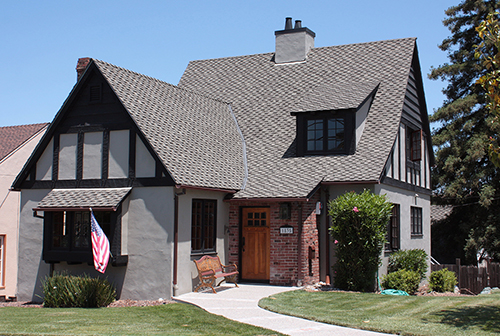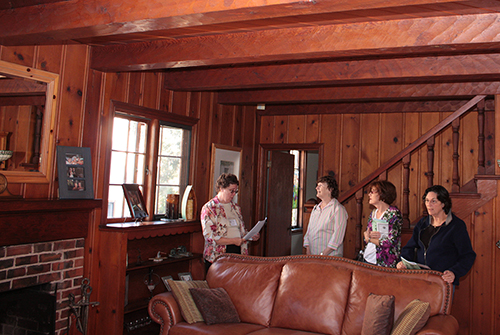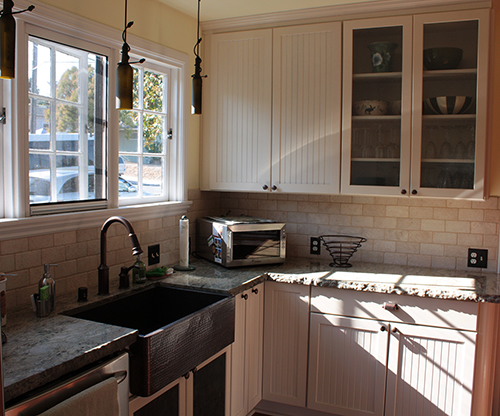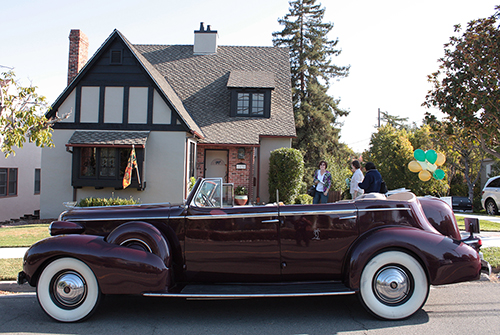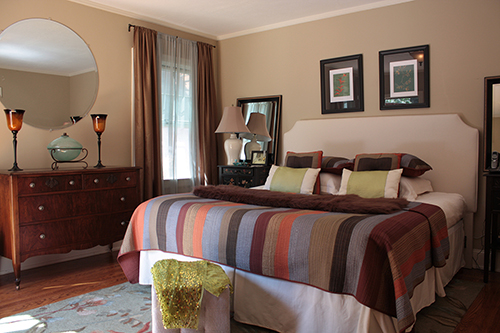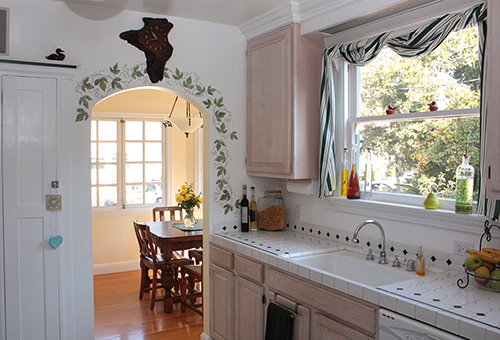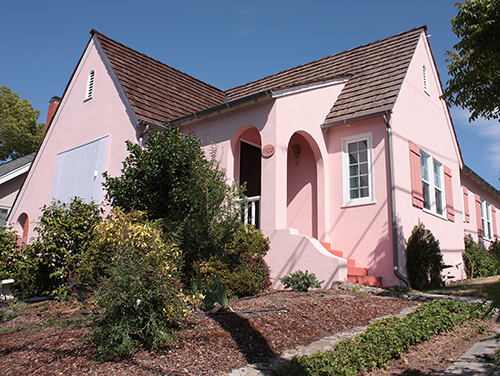2009 Home Tour
|
|
This home at 1835 Pine Street epitomizes the Tudor Revival style which was popular from 1910 - 1940. However, most examples were built before the Stock Market Crash of 1929. Defining characteristics include stuccoed or brick walls, half-timbering, front-facing gables, steep rooflines, and picturesque doors, windows and chimney pots. |
Visitors to the home admire the Tudor style living room. Note the heavy, exposed, ceiling joists of the type used during England's tudor period (1500 -1559). These are genuine hand-hewn beams, not the boxed-in faux beams often used in high-end homes today. |
Stained paneling is used extensively in the public area of the house. The unpainted brick fireplace and the leather furniture reinforce the medival Tudor feel of the living room. The house was designed by noted Berkeley architect, William Strickland. |
The 1920's - 1930's cabinetry and windows remain in the kitchen. The counter top has been updated with a practical material and dropped ceiling lights over work areas make this kitchen more functional than it was originally. The farmhouse sink is a great touch. |
|
A modern stove and hood with a commercial look and feel have been added to the kitchen. They fit in well with the vintage cabinetry and hardware. |
|
The home was built in 1936 and the owners of the home today are Carol Burroughs and Brian Parish. The Cadillac convertible parked in front of their home was manufactured in 1937 and the owner is Robert Schultz. |
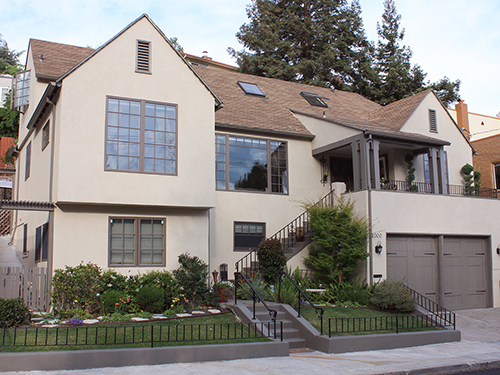 This home at 1000 Arlington Way is a more subdued version of the Tudor Revival Style than the previous example. This home was built a year earlier -- in 1935. Today's proud owners are Robert and Carol Bokelman. This home at 1000 Arlington Way is a more subdued version of the Tudor Revival Style than the previous example. This home was built a year earlier -- in 1935. Today's proud owners are Robert and Carol Bokelman. |
 The living room of this Tudor home is not at all medieval. It is much more conventional for its day (the 1930s) but still retains ceiling beams, hardwood floors and windows with divided lights. The furnishings are both traditional and elegant.
The living room of this Tudor home is not at all medieval. It is much more conventional for its day (the 1930s) but still retains ceiling beams, hardwood floors and windows with divided lights. The furnishings are both traditional and elegant. |
 The kitchen has been sensitively updated with modern appliances and countertops. Functional by today's exacting standards, its still looks appropriate for a 1930's home.
Docent Lucy William's house across the street was on the Home Tour in the prior year.
The kitchen has been sensitively updated with modern appliances and countertops. Functional by today's exacting standards, its still looks appropriate for a 1930's home.
Docent Lucy William's house across the street was on the Home Tour in the prior year. |
 This is the other half of the kitchen. The 1930's cabinetry and hardware, both with solid doors and glass-fronted doors, work well in this kitcen. For an older home, this kitchen has cabinetry and countertops galore. This was due to a later remodel which incorporated the former laundry room into the kitchen.
This is the other half of the kitchen. The 1930's cabinetry and hardware, both with solid doors and glass-fronted doors, work well in this kitcen. For an older home, this kitchen has cabinetry and countertops galore. This was due to a later remodel which incorporated the former laundry room into the kitchen. |
|
 All that need be said about this bath room is that the beautiful vintage tile work is beyond compare. The tile is also very practical in the damp environment of a bath room.
All that need be said about this bath room is that the beautiful vintage tile work is beyond compare. The tile is also very practical in the damp environment of a bath room. |
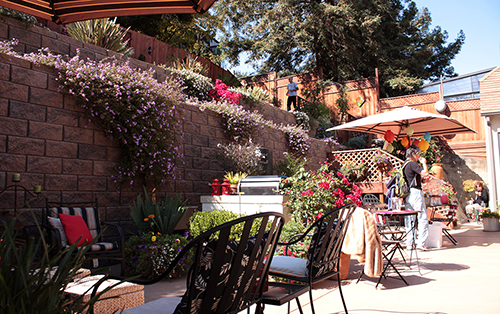 This home was built on a steep hillside to take advantage of the views over Carquinez Strait. These stepped retaining walls were used to carve space out of the hill behind the house for an outdoor living area.
This home was built on a steep hillside to take advantage of the views over Carquinez Strait. These stepped retaining walls were used to carve space out of the hill behind the house for an outdoor living area. |
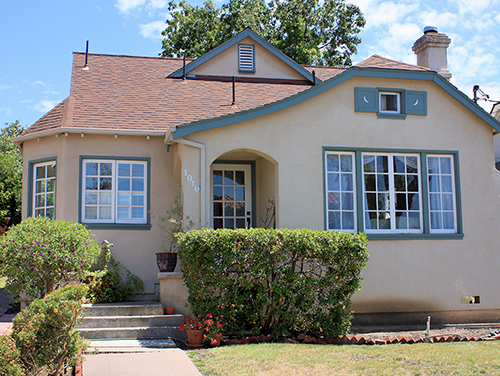 This home at 1010 Brown Street was built in 1928. As was often the case at the time, the builder combined elements of several different styles together to create a pleasing design. Though the house has several English Cottage features (clipped gable and decorative chimney), the Home Tour Commmittee also noted that the home incorporated Mission Revival features. Today's owner is Mitch Avalon.
This home at 1010 Brown Street was built in 1928. As was often the case at the time, the builder combined elements of several different styles together to create a pleasing design. Though the house has several English Cottage features (clipped gable and decorative chimney), the Home Tour Commmittee also noted that the home incorporated Mission Revival features. Today's owner is Mitch Avalon. |
|
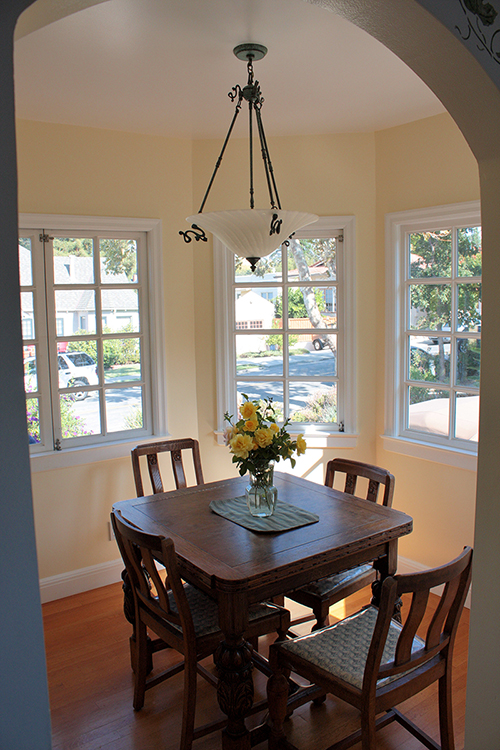 This is a small octagonal breakfast nook just off the kitchen. The nook is barely able to accommodate a table for four, but provides a much more refined eating experience than the kitchen itself. With its multiplicity of windows, the morning light is wonderful.
This is a small octagonal breakfast nook just off the kitchen. The nook is barely able to accommodate a table for four, but provides a much more refined eating experience than the kitchen itself. With its multiplicity of windows, the morning light is wonderful. |
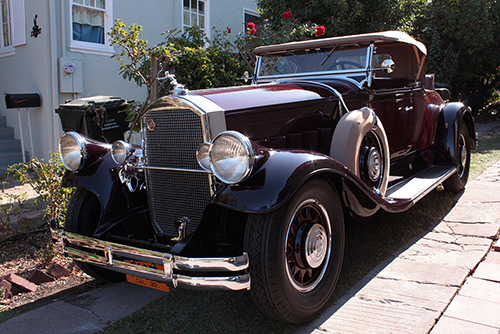 This beautiful Pierce Arrow from the early 1930's was parked next to the house. Pierce Arrow was an American luxury automobile manufacturer which produced the "Mercedes Benz" of its era. The company was hit hard by the Great Depression and went bankrupt in 1938 -- ten years after the house above was built.
This beautiful Pierce Arrow from the early 1930's was parked next to the house. Pierce Arrow was an American luxury automobile manufacturer which produced the "Mercedes Benz" of its era. The company was hit hard by the Great Depression and went bankrupt in 1938 -- ten years after the house above was built. |
|
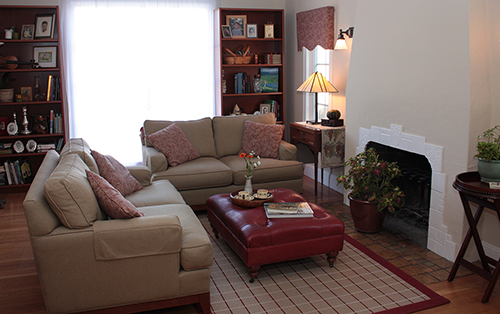 The living room is serene and understated. Note the hardwood floors and the wonderful decorative Art Deco stucco work around the fireplace opening.
The living room is serene and understated. Note the hardwood floors and the wonderful decorative Art Deco stucco work around the fireplace opening. |
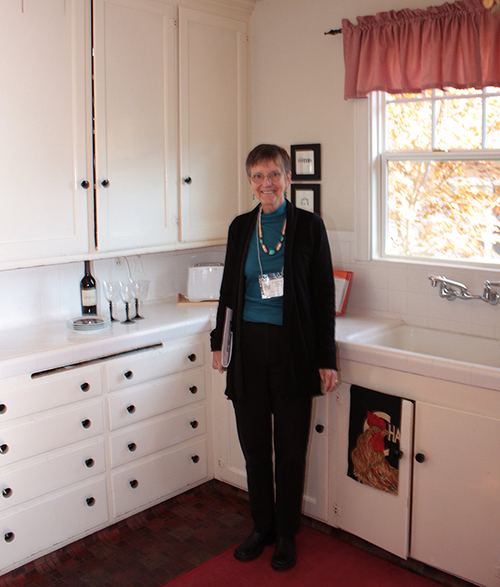 This kitchen is unusual because it has not been remodeled. Everything you see in this photograph is original and dates back to 1935. This includes the cabinetry, counters, the sink and the wall-mounted faucet above the sink.
This kitchen is unusual because it has not been remodeled. Everything you see in this photograph is original and dates back to 1935. This includes the cabinetry, counters, the sink and the wall-mounted faucet above the sink. |
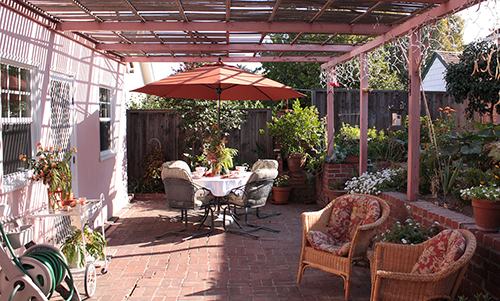 The brick-paved patio behind the house provides the owners with a quite retreat.
The brick-paved patio behind the house provides the owners with a quite retreat. |
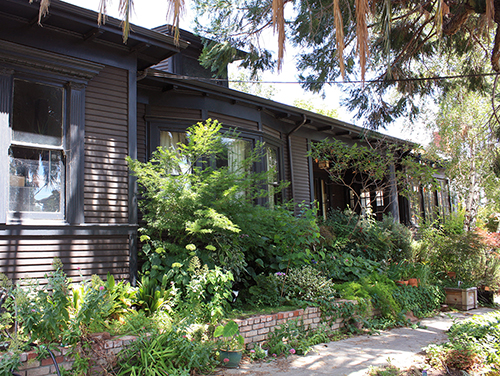 This 1906 home is an example of the transition from Arts & Craft to the Craftsman style. It is locatd at 1305 Willow Street. The owner, Richard Rasmussen, bought the house in 1998. In deplorable condition, he painstakingly restored the building to the condition it is in today.
This 1906 home is an example of the transition from Arts & Craft to the Craftsman style. It is locatd at 1305 Willow Street. The owner, Richard Rasmussen, bought the house in 1998. In deplorable condition, he painstakingly restored the building to the condition it is in today. |
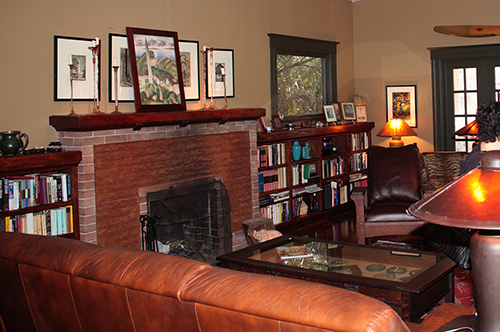 Craftsman houses are well-known for their built-in's -- meant to showcase the skills of the crafstmen who built the home. That is the reason for the custom bookcases which flank the fireplace and line the walls of the living room.
Craftsman houses are well-known for their built-in's -- meant to showcase the skills of the crafstmen who built the home. That is the reason for the custom bookcases which flank the fireplace and line the walls of the living room. |
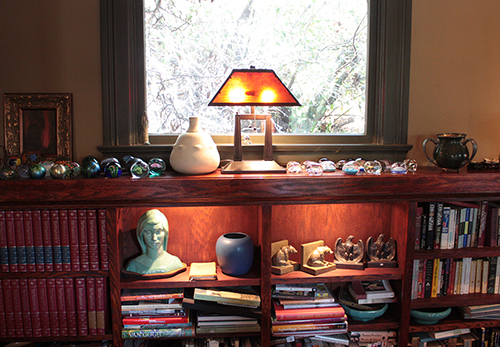 The owner of the home purchased the house because it was suitable for displaying his collections of art, pottery and furniture from the Craftsman Era -- which encompasses both the late 19th century and early 20th century. Note the iconic Craftsman lamp with its mica shade.
The owner of the home purchased the house because it was suitable for displaying his collections of art, pottery and furniture from the Craftsman Era -- which encompasses both the late 19th century and early 20th century. Note the iconic Craftsman lamp with its mica shade. |
There's MORE! Please click here to go to Page 2 of the homes on the 2009 Tour. |
